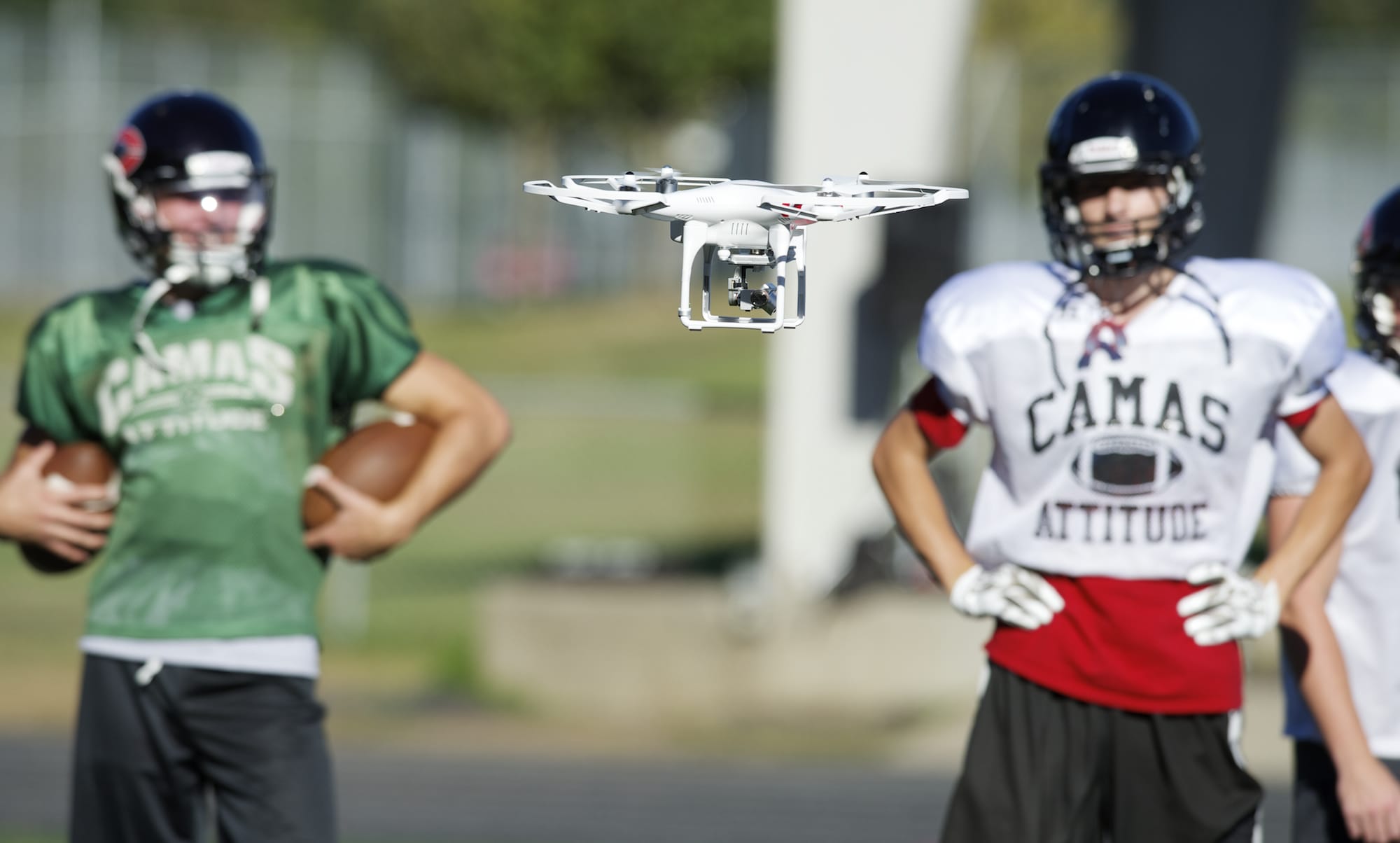CAMAS — There is a new buzz hovering over the Camas football program this season.
Literally.
The propellers whirl, the machine lifts off, and then, about 60 feet off the ground, as it hums with a buzzing sound, the Phantom 2 Vision Quadcopter sets up in perfect position to take video of the team’s practice.
Camas football is using a drone to video practice, giving players and coaches a new vantage point to learn the game.
“It was a little shocking at first, seeing such a clean picture,” senior James Price said. “I couldn’t believe it could be so still and get you the whole field. It’s a spectacular new piece of technology. It gives us a completely new perspective of practice. We can analyze every player … from one camera view.”
Camas coach Jon Eagle said he noticed some college teams were using drones and looked into it.
“The first day, we liked what we saw. It was easy to use,” Eagle said.
Eagle likened it to the “sky cams” that are used by television networks to cover pro and major college football games. Those cameras use cables to maneuver into position, usually above and behind the quarterback.
“What a great, great view that is,” Eagle said. “This is not quite as good, but it’s similar to that.”
Traditionally, coaches have their practices filmed from high points in the end zone — either using towers or tri-pods with extensions. Drones have the capability to move where the practice moves, to hover above the players rather than remain stationary 20, 30 or even 70 yards behind or in front of the action.
Dan Kielty, Camas’ defensive coordinator and unofficial technology geek, was not sure if it would be practical at first. Then he was hooked.
“Once I saw the video and what it could do and how simple is was, I was on board,” Kielty said. “This is going to help us dramatically.”
Camas purchased the system from Aerial Technology International, based in Clackamas, Ore., for close to $1,700. That includes the helicopter, batteries, charger, camera, and video link, according to Stephen Burtt, the CEO of ATI.
“The Phantom is a very popular unit,” Burtt said. “Small. Not very intimidating. Easy for the average person to put it in the air and get a really nice shot.”
Eagle called it a good investment for the Papermakers, adding that public dollars were not used to buy the drone.
“The Camas community, through our fund-raising efforts, purchased it,” Eagle said.
Burtt said his company was based on the idea of putting cameras on helicopters.
“The number of applications and the way people use them just snowballed,” Burtt said. “People are e-mailing us on a daily basis. ‘Can your drone do this?'”
The answer, Burtt said, was almost always yes.
Including football. ATI has sold systems to other football programs. His company is in discussions with an NFL team, as well. Within a few years, he said, look for the practice to become widespread.
“Camas is definitely pioneering new technology,” Burtt said.
Technology in football is nothing new. Coaches have been using photographs of formations and going over game film for years. Old sports movies often depict football coaches using a projector, stopping and starting the film manually, looking for an edge.
It was not that long ago that HUDL was new to the market. Now, just about every team in the Northwest uses the system to analyze games and trade video with a click or two of the computer mouse.
“We help sports teams study themselves and scout their opponents with simple video apps,” the HUDL website states.
Eagle recalled the days of coaches meeting halfway between schools for a film exchange. Or having to make copies of videotapes, then DVDs. Now, with a login and password, players can study video at home on their tablets or computers.
“It’s made it more accessible,” Eagle said. “A great time saver for coaches and kids.”
Will drones be the next big thing?
The only negative, Kielty said, is that the drone can only fly for about 20 minutes at a time before the batteries need to be changed.
Through the first few weeks of practice, there have been no weather issues, but eventually, the Camas coaches will figure out if the drone can handle the Northwest elements.
Burtt said the Phantom 2 should be able to handle light rain. And the helicopter should be able to fly in up to 20-25 mph winds. The system has a stabilizing device so the camera will not shake even if the Phantom drifts a few meters, from side to side, in the wind.
So far, the Camas coaches are impressed.
“It gives you a great angle,” Kielty said. “You can see everybody on the field and the proper angle.”
Eagle said he has a philosophy regarding equipment and technology that he will always have as a head coach.
“We ask, Is it something that will make us better? If it is, and it’s affordable, we’ll buy it,” Eagle said.




